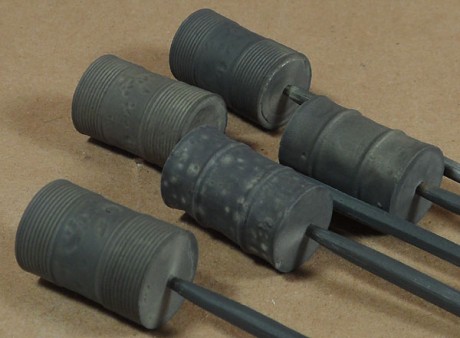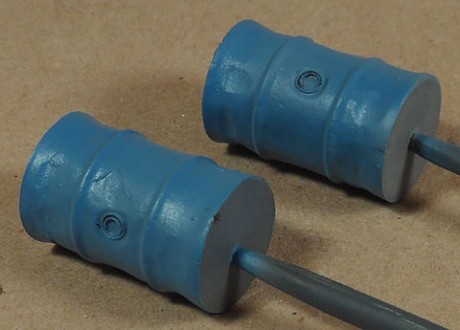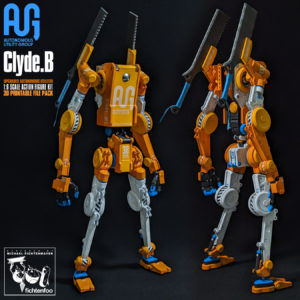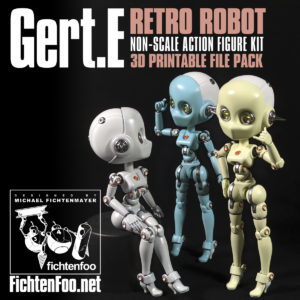Your cart is currently empty!
In Progress » Remora Pair » Cargo
Sorry for the long absence from modeling updates. My work on Industria Mechanika has been keeping me very busy. However now I get to start building and painting the fruits of my labor! The Remora will start shipping from iMech in a few weeks and to help the anticipation go by I started on some cargo. I know… that’s a LOT of cargo for one little ship… that’s because it’s for two ships! One for me and one I’m doing for Ian McQue, the designer of the Remora.
The wooden crates and pallets were made from basswood strips and plywood. The pallets are really easy to make.Each pallet has 12 thin strips and 3 thick strips of basswood about 1.25″ long. There are 7 strips on the top, 5 on the bottom and the 3 thick strips are inbetween. They’re glued together with super glue gel then stained with black india ink and various paints. The large crates are also made from strips and sheets of basswood. The sacks were made with super sculpey with the texture made by pressing the sacks with hockey tape before applying them to the stack.
Brass chain is fairly easy to deal with if you wish to make them rusty. I usually use Rust-All for this. First you want to prime the chain, let cure, then work the chain to unstick any dried primer connecting the links. Next you shake the chain in some of their #4 dirt. This dusts-up the chain and adds texture. Afterwards you dip the chain into the #1 rust liquid. The solution soaks into the dirt which in turn keeps the coating of rust more uniform. Let dry and repeat as necessary. I just did one dirt shake followed by 2 dip and dries in the rust solution.
I purchased a couple of brass bells used for wooden ship models at my LHS. Instead of painting them, I decided to patina them for a more natural weathered look. Simply suspend the brass above some ammonia cleaner in a jar. The ammonia in a few hours will create a very nice dark patina on the brass. If you find your brass not changing, there’s likely a clear-coat applied to prevent it from weathering. Just soak it overnight in some lacquer thinner to remove the clearcoat then do the ammonia jar. This dark patina is also great for photoetch to darken the metal before priming/painting.
AK-Interactive recently sent me some of their chipping fluids to try out. The fluid works the same way as hairspray so if you’re unsure about what hairspray to get, don’t bother as this works the same way and is very uniform. The fluid comes in 2 flavors… Heavy Chipping and Worn Effects. I decided to test them on some barrels.
First I primed the barrels with some self-etching, then dark gray Duplicolor auto primer.
Next I sprayed on several rust-colored random coats of Vallejo Model Air. I coated the barrels in a gloss (mistake!) coat of Future. I should had done flat, but I’ll explain in a bit. Once the clearcoat dried I airbrushed the Heavy on one and the Worn Effects on the other.
When that dried (5-10 minutes) I sprayed on some white, then some blue Tamiya Acrylic.
After the paint dries to the touch you can start removing it with soft toothbrushes or brushes and water. As you can see I got two different chipped looks. However at this stage, it wasn’t because of the difference in the fluids. I did the Heavy Chipping barrel first (right) and when I started on the “Worn” barrel I noticed quickly that it was chipping just as heavy as the first. It only looks less chipped because I didn’t brush it as much. This was due to the gloss coat which I figured out later thanks to some tips on the AK forums. Always use a flat-clearcoat with these.
The rest of the barrels had the gloss clearcoat so the heavier chipping results were the same even thought I used the Worn Effects liquid.
However for the other objects I used the flat-coat AND the worn effects and had much better results. What you see above is after the chipping AND a light sponging of Vallejo rust colors (and lighter thinned base-tones) to get the REALLY fine chips and rust and mottling. Currently I’m waiting on some oil-paint discoloration to dry to further enhance the look and tones.
I had some random parts that I wanted to be really rusty to place on the decks. These were desert tire strips to get tires unstuck from sand and some brass dot-mesh from mechaskunk. I did the same steps as above for the wheel strips, but at the end I sponged on some more thinned yellow (and blue on one) followed with some Vallejo rust sponging and some rust pigment sponging. For the brass mesh I simply sponged on rust colors over the dark gray primer. Then when that was still wet I sponged on a mixture of Vallejo and AK/Mig rust colored pigments. The results are amazing. The white was painted on using water-thinned white pigments. Then I airbrushed on some pigment fixer to seal the pigments in place. Below are all the products I used to get the above 6 rusty panel parts done (except primer and the chipping fluid)
Next update will be more progress on the barrels and other cargo bits.



















![Maude [Cyborg Action-Doll] (Files Only)](https://fichtenfoo.net/blog/wp-content/uploads/2023/01/Maude-Promos-300x300.jpg)


